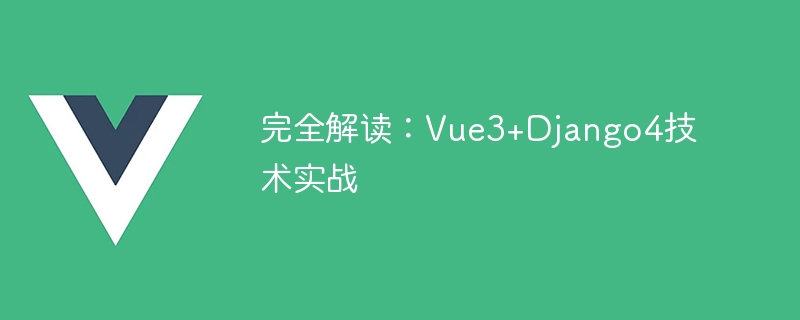

Complete Interpretation: Vue3 Django4 Technical Practice
With the continuous development and application of Internet technology, the architecture model of front-end and back-end separation is increasingly favored by developers. Vue.js and Django, as the most popular JavaScript front-end frameworks and Python back-end frameworks, are widely used in web development. This article will introduce in detail the practical experience of using Vue3 and Django4 for full-stack development.
First of all, we need to understand the basic concepts and usage of Vue.js and Django. Vue.js is a progressive JavaScript framework that implements front-end interface construction and data binding through component development. Django is an efficient and stable Python back-end framework that provides powerful database operation and routing processing capabilities.
Before starting actual combat, we need to prepare the development environment. First, make sure you have Node.js and the npm package management tool installed. You can check the version through the command line:
node -v npm -v
Next, we use the vue-cli command line tool to create a Vue3 project. Enter the following command in the terminal:
vue create my-project
Then select "Manually select features" to manually select the required features, including Babel, Router, Vuex, etc. This allows for personalization based on needs. After creation, enter the project directory:
cd my-project
Install the necessary dependency packages in the project:
npm install
Next, we start developing the front-end interface. In the src directory, create a components folder and create a component file named "HelloWorld.vue" in it. In this component, we can write HTML templates and corresponding JavaScript code.
In the Django project, we need to configure the backend environment. Make sure you have Python3 and Django4 installed, and create a new Django project. You can enter the following command through the command line:
django-admin startproject myproject
Then enter the project directory:
cd myproject
Create an application named "api":
python manage.py startapp api
Next, we need to configure Django's database connection and routing settings. In the settings.py file, configure the database connection parameters. Then in the urls.py file, set the routing of the front-end and back-end APIs.
In the api application of the Django project, we need to create some model classes to define the structure and relationships of the database tables. The corresponding code can be added in the models.py file. Then run the following command to migrate the database:
python manage.py makemigrations python manage.py migrate
Next, we start writing the back-end logic. In API applications, we can create some view classes to handle front-end requests and return corresponding data. The corresponding code can be added in the views.py file.
In the front-end page, we can send requests to the back-end through HTTP request libraries such as axios and process the returned data. Depending on business needs, we can send HTTP requests in methods or lifecycle hooks of Vue components and use the response data to update the page.
After development is completed, we can build the front-end code by running the following command:
npm run build
Then place the compiled static files in the static file directory of the Django project. This ensures that the front-end code is loaded and rendered correctly.
Finally, we need to start the Django development server to run the entire project. In the project directory, run the following command:
python manage.py runserver
In this way, we successfully integrated Vue3 and Django4 and completed a practical project of full-stack development.
During the actual development process, we can also add other functions and optimizations as needed. For example, you can use UI libraries such as Vuetify to provide a richer front-end interface; you can use Django Rest Framework to simplify API development; you can use WebSocket to achieve real-time communication, and so on. Through continuous learning and practice, we can better master the technologies of Vue3 and Django4 and apply them to actual projects.
To sum up, this article details the practical experience of using Vue3 and Django4 for full-stack development. It is hoped that readers can master the basic usage methods of Vue3 and Django4 through the guidance of this article, and be able to use them flexibly in actual projects.
The above is the detailed content of Complete interpretation: Vue3+Django4 technical practice. For more information, please follow other related articles on the PHP Chinese website!